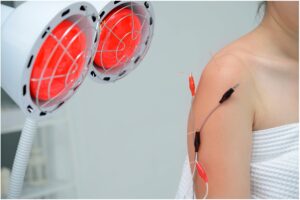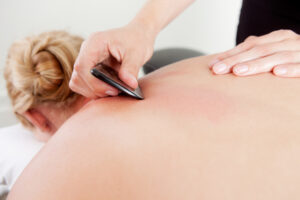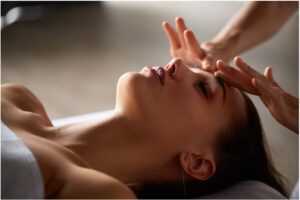Acupuncture
Acupuncture

Assessment and Examination
Insertion of Needles
How can Acupuncture help me?
Here is just a partial list of conditions for which acupuncture has been found to be
effective:
- Fibromyalgia
- Chronic fatigue syndrome
- Headaches and migraines
- Lower back pain and sciatica
- Frozen shoulder
- Arthritis
- Hormonal imbalances
- Knee pain
- Plantar fasciitis
- Neck pain
- Digestive disorders
- Osteoarthritis

Traditional Chinese medicine (TCM) is a type of medicine that has been developed and practiced in China for over five thousand years. It is based on a holistic approach to health and wellness that aims to balance the body's energy, or "Qi" and promote healing. TCM includes a wide range of practices, including acupuncture, herbal medicine, massage, Guasha, and fire cupping. It is still widely practiced in China and Western countries.
There are several types of acupuncture to treat different types of conditions. Electroacupuncture involves the application of a low electric current to the acupuncture needles. It can be used to stimulate or enhance the effects of the acupuncture treatment. Electroacupuncture is thought to help relieve pain, reduce inflammation, and promote healing by increasing blood flow and stimulating the release of natural painkillers in the body. Ear acupuncture can be used to treat a wide variety of conditions, including chronic pain, anxiety, insomnia, and gut issues. It is often used in combination with other forms of acupuncture to provide a more comprehensive treatment approach.
Acupuncture is an ancient practice that forms a part of Traditional Chinese Medicine (TCM) and involves inserting hair-thin needles into specific acupuncture points on the skin. According to TCM, the human body has meridians which circulate Qi, a universal life force energy, to all organs and body systems. Any blockages or imbalances in Qi can lead to pain, dysfunction, and illness. Acupuncture stimulates acupoints along the meridians to restore the balance of Qi, which in turn promotes healing and harmony in the body. Additionally, acupuncture has been scientifically proven to alleviate pain, reduce inflammation, improve blood circulation, facilitate tissue healing, reduce stress and anxiety, and aid in managing addiction.
Modern acupuncture needles are made of flexible stainless steel and are single-use, disposable, and sterile to prevent disease transmission. Unlike hypodermic needles, they have a doweled end, making them less likely to cause tissue damage or bruising. Acupuncture is a safe therapy that aims to restore and maintain natural healing abilities without side effects, performed by a registered acupuncturist.
Although individual experiences vary, most people find acupuncture to be a comfortable and relaxing procedure as the needles used are incredibly thin. This results in minimal pain sensation upon insertion.
Some people don’t feel the needle being inserted at all; those who are more sensitive to needles have described a tingling sensation or the feeling of a small mosquito bite and even then only for a fraction of a second. Most people find the experience of receiving acupuncture relaxing and often people nap while the needles are in place.
Usually, acupuncture produces a sensation at the site of the needle, such as numbness, heaviness, tingling, dull aching, distention, soreness, warmth, or an electric sensation. This sensation, known as "De Qi" in traditional acupuncture, is when a person perceives an acupuncture point relieving.
Acupuncture involves a series of treatments, with an initial one-hour consultation, with follow-up sessions of 45-minute appointments. Response to treatment varies per individual; some conditions may require six or more sessions over weeks or months. Factors such as the type and chronicity of the condition and individual response affect treatment duration. After treatment, maintaining a healthy lifestyle is key to optimizing health.

Cosmetic acupuncture is a non invasive, all natural treatment to improve the overall appearance of your skin. Unlike topical creams or injections, facial acupuncture improves the health and quality of your skin on a much deeper level. The use of acupuncture needles and small intra dermal needles creates micro trauma into the layers of your skin, this increases blood and lymphatic flow to nourish and firm tissues, promote healing, hydration, and aid in tissue detox. This process also boosts the production of collagen and elastin, which play a role in tissue repair and regeneration and provides firmness and elasticity to the skin.
Just like regular body acupuncture, there may be some mild pain on insertion of the needles. Some areas, like around the lips and eyes are more sensitive, so smaller needles are used. Any pain felt should be mild and temporary, and if any needles are causing significant discomfort they can be removed or adjusted.
Side effects include the possibility of mild bruising around needle sites, or redness/petechia (small red spots similar to a bruise) after facial cupping/gua sha. These depend on how sensitive your skin is to bruising and redness. Gentle techniques are used to start with until the practitioner gets to know your skin, if tolerated well, deeper and more intense work may be applied.
We recommend 5-10 treatments, one week apart to get the best results from facial acupuncture. Continuing with monthly appointments for maintenance. However coming in for a few one off appointments through out the year, for an extra glow up (prior to an event, self care etc) can still be beneficial.
Yes, because the treatment is administered by a licensed Acupuncturist, this treatment is covered through acupuncture insurance.
Treatment includes, body acupuncture (resolve any imbalances that may be contributing to skin issues), facial/scalp acupuncture, cupping to chest/neck and face, application of facial oil, and/or gua sha or the use of an Ayurvedic Kansa want to balance ph levels in skin.
Cosmetic acupuncture can help improve the appearance of fine lines and wrinkles, blemishes, enlarged pores, puffiness, discolouration or skin damage, brighten a dull complexion and preserve the elasticity in skin. This treatment will have less effect on deeper set wrinkles.
Ideally, you should come with a clean, makeup free face. Face wipes will be provided if needed, if you have skin sensitivities or prefer certain products, consider bringing your own.

Fire cupping is a traditional Chinese medicine technique that involves placing glass cups on the skin and using fire to create a vacuum, which draws the skin and underlying tissue into the cup. Fire cupping increases blood flow and promotes healing.
Fire cupping can be uncomfortable, but it's generally not considered painful. Clients usually report feeling warmth at the location of cupping and relaxation. However, if the cups are left in place for too long, they can cause bruising or discomfort. It's important to have fire cupping done by a certified practitioner who can adjust the treatment to your individual needs and preferences.
Fire cupping is a traditional Chinese therapy technique that involves creating suction inside special cups placed on the skin. It involves heating the cups with fire to create a vacuum and then placing the cups on specific areas of the body, usually the back, though other areas can be done as well.
The duration of bruising from fire cupping can vary depending on the individual and the intensity of the treatment. Circular marks are left by the cups and will disappear within a few days to a week. However, in some cases, the bruises can last up to two weeks. It's important to review your health history with your practitioner if fire cupping is a good treatment for you.
Yes! Traditional Chinese Medicine (TCM) describes the universal life force energy, Qi, which flows through channels called meridians in the body. Any blockages or imbalances in the Qi can indicate illness. Cupping massage utilizes suction and pressure to move Qi, release toxins, and clear blocked tissues up to four inches deep from the external skin.
As the cups cool, they create suction that pulls the skin and underlying tissues upwards into the cup, which may cause some redness or bruising. The suction can help to promote blood and lymphatic flow, alleviate muscle tension, and release toxins from the body.
Yes! Fire cupping is often used in combination with other types of therapy such as acupuncture, massage, or herbal remedies to help promote overall health and healing. At Inspire, we believe in collaborative treatment and a holistic approach to health.
Guasha (Scraping)

Scraping therapy, also known as Gua Sha, is a traditional Chinese healing technique that involves the use of a flat tool, typically made of jade, bone, or other materials, to scrape the skin repeatedly in a specific direction. Scraping is used in combination with other treatments to treat injuries, initiate lymphatic drainage, and encourage relaxation.
During a scraping therapy session, the therapist applies oil to the skin and then uses a scraping tool to apply pressure to the skin, moving the tool in a back-and-forth motion over the muscles and connective tissue. Scraping therapy promotes the flow of qi (life force energy) and blood, helps release tension and stagnant energy in the body's tissues. It is often used to treat chronic pain, muscle tension, headaches, and respiratory conditions.
Anyone can purchase a scraping tool however, it should be noted that scraping therapy should be done by a trained and licensed practitioner, as improper technique or over-application of pressure can result in injury and bruising. Book yourself an appointment with our qualified therapists at Inspire if Scraping is a good treatment for you!
Chinese Herbal Medicine
Herbal medicine involves using all parts of plants such as roots, leaves, and flowers for medicinal purposes. Chinese Herbal Medicine is a vital aspect of Traditional Chinese Medicine with a history from 3rd century BC. Herbal treatment is predominantly used in China and has made its way to Western culture. Additionally, they are often used with other remedies like acupuncture to provide long-lasting relief. Herbal medicine is continuously evolving, with ongoing research and development improved by modern medical diagnostic techniques. Notably, Chinese pharmacologist Tu Youyou won the 2015 Nobel Prize in Physiology or Medicine for successfully using traditional Chinese herbal medicine as an alternative in treating malaria.
- After reviewing your health history and concerns, our therapists can develop a treatment plan customized to you. Traditional Chinese Medicine formulas usually combine 8-12 herbs and may be prescribed in pill or extract form or as dried herbs to make a tea. Administering the proper treatment plan can allow the herbal medicine to treat several health concerns at the same time.
Chinese herbal medicine can treat chronic conditions, including metabolic diseases, chronic and degenerative conditions, age-related diseases, allergy and asthma. Individuals can greatly benefit from the use of herbal medicine as an alternative when Western medication is limited. Chinese herbal medicine rebalances internal biological systems rather than treating symptoms alone. Furthermore, herbal medicine strengthens the immune system and promotes natural well-being.
Acupressure

Acupressure therapy is based on the same principles as acupuncture, but instead of needles, pressure is applied to these points. The pressure may be applied in a circular or kneading motion, or held still for a certain period of time, depending on the treatment approach. Acupressure is a great alternative for people who have underlying health conditions who cannot seek acupuncture.
Acupressure therapy can be used to help treat a variety of conditions, including chronic pain, headaches, anxiety, insomnia, digestive problems, and more. It is often used as a complementary therapy alongside conventional medical treatments. Acupressure therapy can treat a wide range of people from children to the elderly!
Acupressure therapy is generally considered safe when performed by a qualified and licensed practitioner. It is essential to share your full medical history with your therapist, so they can choose the best and safest techniques and points to use in your treatment. Come visit us at Inspire if acupressure is a treatment that fits your needs!
